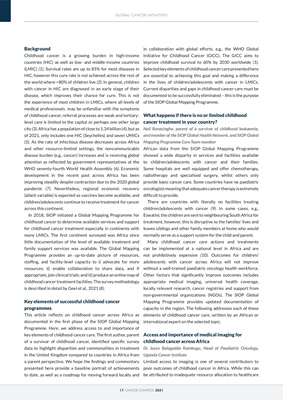
GLOBAL CANCER INITIATIVES
17 CANCER CONTROL 2021
Background
Childhood cancer is a growing burden in high-income
countries (HIC) as well as low- and middle-income countries
(LMIC) (1). Survival rates are up to 85% for most diseases in
HIC, however this cure rate is not achieved across the rest of
the world where >80% of children live (2). In general, children
with cancer in HIC are diagnosed in an early stage of their
disease, which improves their chance for cure. This is not
the experience of most children in LMICs, where all levels of
medical professionals may be unfamiliar with the symptoms
of childhood cancer, referral processes are weak and tertiarylevel
care is limited to the capital or perhaps one other large
city (3). Africa has a population of close to 1.34 billion (4), but as
of 2021, only includes one HIC (Seychelles) and seven UMICs
(5). As the rate of infectious disease decreases across Africa
and other resource-limited settings, the noncommunicable
disease burden (e.g., cancer) increases and is receiving global
attention as reflected by government representatives at the
WHO seventy-fourth World Health Assembly (6). Economic
development in the recent past across Africa has been
improving steadily despite contraction due to the 2020 global
pandemic (7). Nevertheless, regional economic recovery
(albeit variable) is expected as vaccines become available, and
children/adolescents continue to receive treatment for cancer
across this continent.
In 2018, SIOP initiated a Global Mapping Programme for
childhood cancer to determine available services and support
for childhood cancer treatment especially in continents with
many LMICs. The first continent surveyed was Africa since
little documentation of the level of available treatment and
family support services was available. The Global Mapping
Programme provides an up-to-date picture of resources,
staffing, and facility-level capacity to i) advocate for more
resources; ii) enable collaboration to share data, and if
appropriate, join clinical trials; and iii) produce an online map of
childhood cancer treatment facilities. The survey methodology
is described in detail by Geel et al., 2021 (8).
Key elements of successful childhood cancer
programmes
This article reflects on childhood cancer across Africa as
documented in the first phase of the SIOP Global Mapping
Programme. Here, we address access to and importance of
key elements of childhood cancer care. The first author, parent
of a survivor of childhood cancer, identified specific survey
data to highlight disparities and commonalities in treatment
in the United Kingdom compared to countries in Africa from
a parent perspective. We hope the findings and commentary
presented here provide a baseline portrait of achievements
to date, as well as a roadmap for moving forward locally and in collaboration with global efforts, e.g., the WHO Global
Initiative for Childhood Cancer (GICC). The GICC aims to
improve childhood survival to 60% by 2030 worldwide (1).
Selected key elements of childhood cancer care presented here
are essential to achieving this goal and making a difference
in the lives of children/adolescents with cancer in LMICs.
Current disparities and gaps in childhood cancer care must be
documented to be successfully eliminated - this is the purpose
of the SIOP Global Mapping Programme.
What happens if there is no or limited childhood
cancer treatment in your country?
Neil Ranasinghe, parent of a survivor of childhood leukaemia,
and member of the SIOP Global Health Network, and SIOP Global
Mapping Programme Core Team member
African data from the SIOP Global Mapping Programme
showed a wide disparity in services and facilities available
to children/adolescents with cancer and their families.
Some hospitals are well equipped and offer chemotherapy,
radiotherapy and specialised surgery, whilst others only
provide basic cancer care. Some countries have no paediatric
oncologists meaning that adequate cancer therapy is extremely
difficult to provide.
There are countries with literally no facilities treating
children/adolescents with cancer (9). In some cases, e.g.,
Eswatini, the children are sent to neighbouring South Africa for
treatment, however, this is disruptive to the families' lives and
leaves siblings and other family members at home who would
normally serve as a support system for the child and parent.
Many childhood cancer care actions and treatments
can be implemented at a national level in Africa and are
not prohibitively expensive (10). Outcomes for children/
adolescents with cancer across Africa will not improve
without a well-trained paediatric oncology health workforce.
Other factors that significantly improve outcomes includes
appropriate medical imaging, universal health coverage,
locally relevant research, cancer registries and support from
non-governmental organizations (NGOs). The SIOP Global
Mapping Programme provides updated documentation of
capacity in the region. The following addresses each of these
elements of childhood cancer care, written by an African or
international expert on the selected topic.
Access and importance of medical imaging for
childhood cancer across Africa
Dr Joyce Balagadde Kambugu, Head of Paediatric Oncology,
Uganda Cancer Institute
Limited access to imaging is one of several contributors to
poor outcomes of childhood cancer in Africa. While this can
be attributed to inadequate resource allocation to healthcare